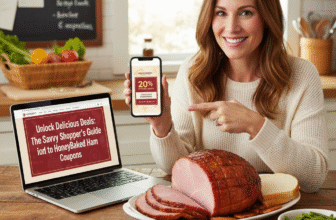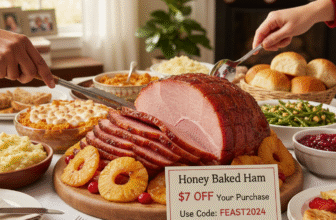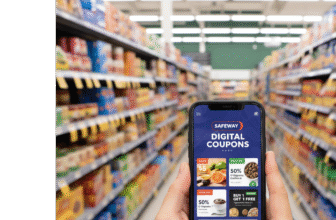
Slash Your Grocery Bill: The Ultimate Guide to Finding and Using Food Coupons Like a Pro
Let’s be real for a second: that feeling when you watch the total at the grocery checkout climb higher and higher is a universal dread. Food costs seem to be on a perpetual upward trajectory, and for many American families, that weekly grocery run can feel like a major financial hurdle. But what if I told you there’s a time-tested, surprisingly simple way to fight back against rising prices and reclaim a significant chunk of your food budget? I’m talking about coupons. And no, this isn’t about your grandma meticulously clipping coupons from the Sunday paper for hours (though that can still be part of the strategy!). In today’s digital age, the world of food coupons has evolved into a dynamic, tech-savvy landscape that can put hundreds, even thousands, of dollars back into your pocket each year. This is your definitive guide to mastering the art of the food coupon, transforming you from a casual shopper into a savvy saver.
A Quick Trip in the Coupon Time Machine
Before we dive into the nitty-gritty of digital apps and coupon stacking, let’s appreciate the humble origins of our topic. The first coupon is widely credited to Coca-Cola back in 1887. Asa Candler, a savvy businessman, distributed handwritten tickets for a free glass of his new, peculiar-tasting beverage. The idea was revolutionary: give people a taste for free, and they’ll come back for more. It worked like a charm. By 1913, Coca-Cola had redeemed over 8.5 million of these “free drink” coupons. This simple marketing tactic laid the groundwork for a multi-billion dollar industry that has helped shape American consumerism for over a century. From the post-war boom of the 1950s, where coupon clipping became a hallmark of the frugal housewife, to the “extreme couponing” craze of the 2010s, saving money with a slip of paper (or a barcode on a screen) has remained a deeply ingrained part of our shopping culture.
Decoding the Coupon: Understanding the Different Types

Navigating the coupon world can feel like learning a new language at first, with its own jargon and rules. The first step to becoming a savings expert is understanding the key players. Primarily, food coupons fall into two main categories:
- Manufacturer Coupons: These are the most common type. They are issued by the brand that produces the product (think Kraft, General Mills, or Kellogg’s). When you use a manufacturer coupon, the store accepts it as partial payment, and the manufacturer later reimburses the store for the discount, often with a small handling fee. These coupons will always say “Manufacturer Coupon” on them and can typically be used at any store that accepts coupons.
- Store Coupons: These are issued by the retailer itself (like Target, Kroger, or Safeway). They are a way for the store to drive traffic and promote specific items. You can only use these coupons at the specific store or chain that issued them. They will be clearly branded with the store’s logo and might be labeled “Store Coupon” or have a unique store-specific barcode format.
The real magic happens when you find a store that allows “coupon stacking.” This is the holy grail for savers, and we’ll explore it more deeply later. It means you can use one manufacturer coupon AND one store coupon on the exact same item, effectively doubling your discount!
Your Treasure Map: Where to Find the Best Food Coupons
Gone are the days when the Sunday newspaper was your only source for savings. Today, coupons are everywhere, hiding in plain sight. You just need to know where to look. Building a diverse coupon-hunting strategy is key to maximizing your savings.
1. The Digital Frontier: Apps and Websites
This is where modern couponing truly shines. Your smartphone is your most powerful savings tool.
- Store-Specific Apps: Nearly every major grocery chain has its own app (Kroger, Publix, Safeway, Albertsons, etc.). These are essential. You can digitally “clip” coupons directly to your store loyalty card. When you check out and enter your phone number or scan your card, the discounts are applied automatically. No paper, no fuss.
- Cash-Back & Rebate Apps: These apps work a little differently but are incredibly valuable. Apps like Ibotta, Fetch Rewards, and Checkout 51 give you cash back after your purchase. You browse offers in the app, buy the qualifying products at any participating store, and then scan your receipt. The app verifies your purchase and deposits cash into your account, which you can later transfer to PayPal or redeem for gift cards. The beauty here is that you can often stack these rebates on top of traditional manufacturer and store coupons you used at the register!
- Printable Coupon Websites: Websites like Coupons.com, SmartSource.com, and RetailMeNot Everyday (formerly RedPlum) are massive databases for printable manufacturer coupons. You can browse, select the coupons you want, and print them out at home. Pro tip: you can usually print two of each coupon per device, so if you have a laptop and a desktop, you can print four!
2. Old School, Still Cool: Traditional Paper Sources
Don’t discount the classics! They still hold a ton of value.
- The Sunday Newspaper: This is still the king for high-value coupons for food and household goods. The coupon inserts, typically from providers like SmartSource (SS), Save (formerly RetailMeNot/RedPlum), and P&G (Procter & Gamble), are packed with deals. If you’re serious about saving, a Sunday paper subscription can pay for itself many times over.
- In-Store Finds: Keep your eyes peeled as you shop. You can often find coupons right where you need them. Look for “Blinkies” (little machines with a blinking light that dispense coupons), “Peelies” (coupons stuck directly onto the product’s packaging), and “Tearpads” (pads of coupons found on shelves or displays).
- Catalinas: These are the long, receipt-like coupons that print out from a separate machine at the register after you pay. They are often triggered by something you purchased. For example, buying a certain brand of coffee might trigger a Catalina coupon for $1 off your next purchase of that same coffee. They can also be for a general discount, like “$5 off your next shopping trip of $50 or more.” Always check these before you toss them!
From Novice to Ninja: Advanced Couponing Strategies
Once you’ve got the hang of finding coupons, it’s time to level up your game. This is how you go from saving a few dollars to cutting your grocery bill in half.
Mastering the Stack
As mentioned, coupon stacking is the cornerstone of big savings. Let’s paint a picture. Imagine a box of your favorite cereal is on sale for $3.00.
- You have a $0.50 off store coupon from their weekly ad.
- You also have a $0.75 off manufacturer coupon you printed online.
- And the Ibotta app has a $0.50 cash-back offer for that same cereal.
A store that allows stacking lets you use both the store and manufacturer coupons at the register. Your initial cost drops from $3.00 to $1.75 ($3.00 – $0.50 – $0.75). Then, you scan your receipt into Ibotta and get another $0.50 back. Your final cost for that box of cereal? A mere $1.25. That’s a 58% savings from the sale price alone!
Timing is Everything: Marrying Coupons with Sales
The golden rule of couponing is this: Never use a coupon on a full-price item unless you absolutely have to. The true power of a coupon is unleashed when you pair it with a sale. Grocery stores operate on sales cycles, meaning the same items tend to go on sale every 6-8 weeks. Your goal is to collect coupons for your family’s favorite non-perishable items and wait for them to hit a rock-bottom sale price. When the sale hits, you use your coupons to get the items for pennies on the dollar or even for free. This is how you build a strategic stockpile of items you know you’ll use, ensuring you never have to pay full price for things like pasta, canned goods, or toiletries again.
Know the Rules of the Game
Every store has its own coupon policy, and it’s crucial to know it. You can usually find it on their website or by asking at customer service. Key things to look for:
- Do they allow stacking?
- Do they double coupons? (Some stores will double the value of manufacturer coupons up to a certain amount, like $0.50 or $0.99).
- Is there a limit on how many “like” coupons you can use in one transaction?
- Do they accept printed coupons? Are there any restrictions on them?
Knowing the policy not only helps you maximize savings but also makes for a smoother, faster checkout process for you, the cashier, and the people in line behind you.
Common Pitfalls and How to Sidestep Them
The road to savings can have a few bumps. Here are some common mistakes to avoid on your couponing journey.
- The “It’s a Deal!” Trap: Don’t buy something you won’t use just because you have a great coupon. A 25-cent jar of pickled herring is no bargain if it’s just going to rot in your pantry. Stick to products your family already loves or is genuinely interested in trying.
- Forgetting Expiration Dates: An expired coupon is just a worthless piece of paper. Get organized! Whether you use a small accordion file, a binder with baseball card sleeves, or a simple envelope system, find a method that works for you to keep track of your coupons and their expiration dates.
- Ignoring the Fine Print: Read the coupon carefully. Does it apply to a specific size or variety? Is there a limit of one per customer? Misreading the terms can lead to frustration at the checkout counter.
- Coupon Fraud: This is a serious issue. Never, ever photocopy a coupon. It’s illegal and hurts everyone—the stores, the manufacturers, and honest couponers. Similarly, avoid buying or trading coupons from sketchy online sources. Stick to legitimate channels.
The Future is Personalized and Digital
The world of food coupons is constantly evolving. The trend is moving away from one-size-fits-all paper inserts and toward highly personalized digital offers. Stores are using your shopping data (via loyalty cards) to send you coupons and deals specifically tailored to your buying habits. If you frequently buy a certain brand of yogurt, don’t be surprised to get a digital coupon for that exact product sent to your app. This targeted approach means less time sifting through irrelevant offers and more time saving on the things you actually want to buy. Artificial intelligence and machine learning will only make these offers more precise, creating a seamless and highly efficient savings experience for the shopper of the future.
Getting started with food coupons might seem daunting, but it’s a skill that pays real dividends. Start small. Try downloading your grocery store’s app and clipping a few digital coupons for your next trip. Then, maybe grab a Sunday paper and see what you find. As you get more comfortable, you can explore stacking, rebate apps, and strategic shopping. It’s not about extreme measures; it’s about being a smarter, more mindful consumer. By reclaiming control over your grocery budget, you’re not just saving money—you’re freeing up resources for other things that matter, whether it’s a family vacation, paying down debt, or simply having a little more breathing room each month. So go ahead, clip that coupon. Your wallet will thank you.







